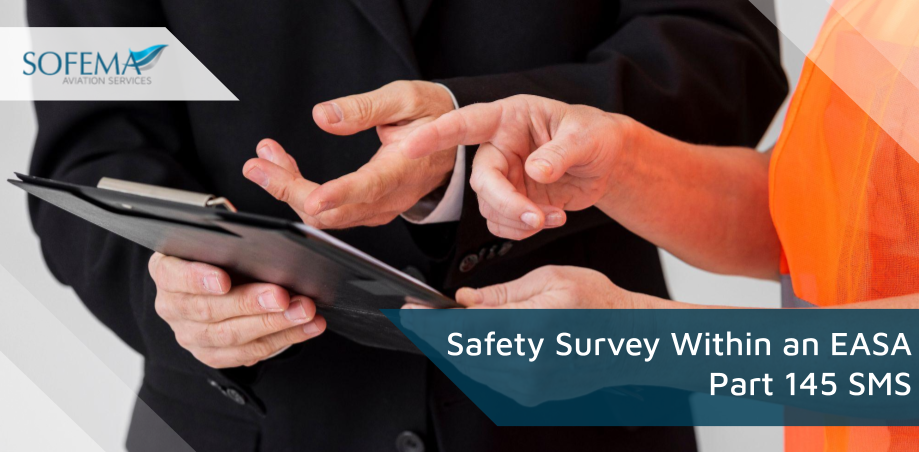Sofema Aviation Services (SAS) www.sassofia.com takes a deep dive into the subject to understand the merits of an effective safety survey process and the benefits for the organization.
Introduction
EASA does not mandate a standard for surveys, this is left to the discretion of the organization to develop.
Unfortunately, this creates a challenge for both the organization as well as the competent authority
- An organization whose focus is on demonstrating compliance with the regulations may underperform in this area
- The regulatory authority for its part is challenged to perform effective audits where no criteria exist as a reference point.
Reality Check
At the end of the day, it requires a high level of motivation and willingness of the safety team to encourage engagement through multiple activities to achieve the best safety system outcomes.
Support information and Guidance – Please see additional background content related to developing effective surveys
Delivering an effective EASA (European Union Aviation Safety Agency) Part 145 survey requires a strategic approach, ensuring that the survey effectively engages with the Safety Management System (SMS) communication objectives.
Here are key guidelines to consider for an optimal survey format:
- Define Clear Objectives: Start by clearly defining the objectives of the survey. What specific aspects of the SMS do you want to assess or improve?
o This could include areas such as hazard identification, risk management, safety assurance, and safety promotion.
- Target Audience Identification: Identify the target audience for the survey.
o This could include maintenance personnel, management, and other stakeholders. Understanding their level of knowledge and engagement with the SMS is crucial for crafting relevant questions.
- Questionnaire Design:
o Types of Questions: Use a mix of closed-ended questions (like multiple choice or Likert scale) for quantitative analysis and open-ended questions for qualitative insights.
- Clarity and Relevance: Ensure questions are clear, concise, and directly related to SMS components. Avoid technical jargon unless your audience is familiar with it.
- Anonymity and Confidentiality: Assure respondents that their responses are anonymous and confidential to encourage honest feedback.
- Survey Distribution and Timing: Choose a method of distribution that is easily accessible to your audience, such as online platforms or paper-based surveys if more appropriate.
o Consider the timing of the survey to ensure maximum participation, avoiding busy operational periods.
- Encouraging Participation: Communicate the purpose and importance of the survey to potential respondents.
o Consider incentivizing participation if appropriate and feasible.
- Data Analysis and Feedback: Analyze the collected data systematically to identify trends, areas of strength, and areas needing improvement.
o Provide feedback to the participants and stakeholders about the survey findings and any intended actions. This step is critical for closing the communication loop and demonstrating that their input is valued and leads to tangible changes or improvements.
- Action Plan Development:
o Based on the survey results, develop an action plan to address the identified issues or to reinforce positive findings.
o Ensure that the action plan aligns with the overall objectives of the SMS and includes clear responsibilities and timelines.
-
- Follow-Up: Regularly review the effectiveness of implemented actions.
o Consider conducting follow-up surveys to measure the impact of changes made and to ensure continuous improvement.
By following these guidelines, you can create an EASA Part 145 survey that effectively engages with your
Please see Sofema Download Area – 145 SMS Implementation to access a document with multiple example surveys for additional guidance https://sassofia.com/download-area/
Next Steps
Follow this link to our Library to find & Download related documents for Free.
Sofema Aviation Services (www.sassofia.com) and Sofema Online (www.sofemaonline.com) provide multiple SMS courses including Implementation, Hazard & Risk Assessment.
Tags:
Aviation Safety Assurance, target audience, implemented actions, continuous improvement, stakeholders, constructive feedback, EASA Part 145 Safety Management System, Data Analysis, safety surveys, Compliance, Safety promotion, SAS Download Area, SAS blogs, SMS, Feedback, Safety Risk Management, EASA





